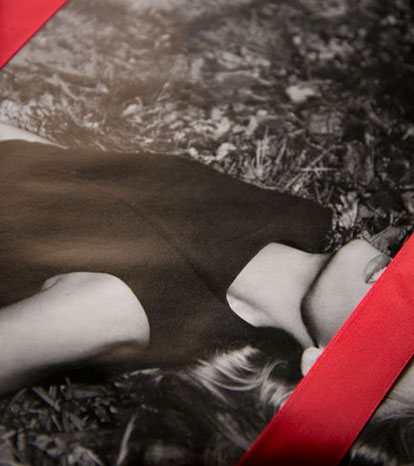
Photographic images have traditionally depicted space, revealing people and objects, they are the stuff of illusion. They are also things. At the intersection of these identities is a kind of gooey vacillation as we look at and through a photographic image in contemporary culture. The body of work, Photos of Gifts plays with this vacillation ad nauseam. The work seems to depict exactly what the title, Photos of Gifts, describes, however, objects are often wrapped with images complicating illusionistic space, as well as, obscuring object identities. Photographs as objects become part of the image construction, acting as things and simultaneously describing them. Space is represented only to be flattened and broken. Scenes are constructed and composed as a drawing or painting and completed with clues to their spatial falsity. A seemingly fictitious space is created that belies and pronounces the archaic assumptive truth telling aspect of the photograph. Depth and flatness become one tactic, breaking in upon one another promiscuously. These images don’t so much capture a past but hint at a transition. They are portraits of an object in a transient state, a brief state as the gift object, pampered and prepared, veiled and decorated, ready to be torn open and revealed. The ephemerality of the gift object, and of the photographic moment, in general, are collapsed and conflated with a wink. The final, framed work continues this masquerade, a self-aware, over the top metaphor of the wrapping and primping which is so integral to the art object. These works are in themselves an unashamed commodity and yet also an instigator, asking questions of the audience who desires them. Boldly and conspicuously, my images question their own identity, the answer lost in color and irony.
This arguably absolute objecthood of the photograph is compounded in these works with the history of the woman as object so intricately outlined by her representation in the photographic/ film medium. Using pages of contemporary fashion and art magazines as wrapping paper in these works becomes slightly facetious in its overtness. Women acting as objects for advertisement are transformed to the focused subjects of my images only to then be literally flattened, inextricable from the object portrait, as they are wrapped around that object and tied with a bow. The subject/ object balance gets a sea sickening treatment. The works have a level of performance, representing an object manipulated and prepared for a brief but secretive moment which playfully hides their actual identity. Titles hint at this performance taking on a diaristic role, overtly referencing the actual gift and its intended recipient which often seems incongruous with the image. This is a blunt reference to the lie of the photograph. Barthes’ ‘that has been’ moment which can never be again is treated with intention and without regret, without loss. The presence of the present implies duration which is essential to, and of course, contradictory to, ephemerality. The frivolity and temporality of bows and ribbons brings care in close and surprising contact with the critical.


